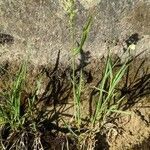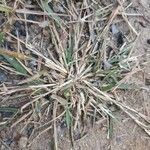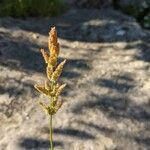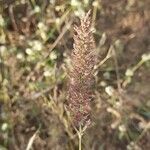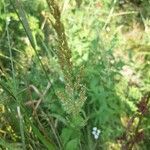Perennial, stoloniferous; stolons slender, spreading, rooting at nodes. Culms geniculately ascending, 20–100 cm tall. Leaf blades linear, flat, 3–12 cm, 2–8 mm wide, scaberulous on both surfaces, apex acute; ligule 2–5 mm. Panicle contracted, lanceolate to oblong, lobed and often interrupted, 5–15 cm; branches semiverticillate, ascending, bearing densely clustered spikelets. Spikelets narrowly oblong, 1.5–2.5 mm; glumes narrowly elliptic-oblong, scabrid, lightly keeled upward, apex obtuse, awnless; lemma broadly elliptic, ca. 1 mm, awnless, apex truncate, minutely denticulate; palea almost as long as lemma. Stamens 3, anthers 0.4–0.7 mm. Caryopsis oblong, ca. 1 mm.
Robust erect or geniculately ascending stoloniferous perennial. Culms to c. 60 cm high, ± 3–6-noded, smooth. Leaves scattered; basal sheaths glabrous, striate to shallowly grooved, becoming loose in upper part; ligule 2–5 mm long, truncate, lacerate; blade flat, linear, to 18 cm long, 2–10 mm wide. Panicles contracted, to 15 cm long, exserted; branches alternate in clusters of 1–many, bearing spikelets almost to base. Spikelets disarticulating below glumes and falling entire, c. 1.5–2 mm long. Glumes subequal, 1.5–2 mm long. Lemma ovate, c. 1 mm long, denticulate, awnless, 5-nerved, glabrous. Palea slightly shorter than lemma. Anthers 0.4–0.5 (–0.7) mm long.
Stoloniferous perennial or annual, 150-600 mm high; often rooting at nodes. Leaf blade up to 150 x 7 mm; ligule an unfringed membrane. Inflorescence an open, interrupted panicle; branches ascending. Spikelets 1.5-2.0 mm long, narrowly oblong, awnless, falling with glumes and pedicel or part of it; glumes ± equal, longer than spikelet, scabrid across back, margins minutely hairy. Floret 1; anther 0.4-0.5 mm long. Flowering time Sept.-Apr.
Perennial or annual 150-600 mm high; stoloniferous; culms often rooting at the nodes. Leaf blade to 150 x to 7 mm. Inflorescence open, interrupted, branches ascending. Spikelet 1.5-2.0 mm long, narrowly oblong; glumes scabrid across the back, margins minutely hairy, awnless; lemma awnless; anther 0.4-0.5 mm.
Annual or perennial, up to 0.6 m tall. Leaves linear-lanceolate; ligule an unfringed membrane. Inflorescence an open panicle. Spikelets 1.5-2 mm long, disarticulating as an entire unit, awnless; lemmas glabrous, shiny.
Annual; up to 0.6 m high. Leaf blades up to 150 x 7 mm. Flowers: panicle ± open; branches ascending; spikelets 1.5-2.0 mm long; glumes and lemmas not awned; anthers 0.4-0.5 mm.
Annual, up to 0.6 m high. Leaf blades up to 150 mm long, up to 7 mm wide. Spikelets 1.5-2.0 mm long. Panicle open, branches ascending; lemmas awnless.
Annual or perennial to 60 cm. Leaves linear-lanceolate. Spikelets in an open panicle, glumes and lemmas awnless.
A grass. It grows 60 cm tall. The leaves are narrow and sword shaped. They are 15 cm long by 7 mm wide.
